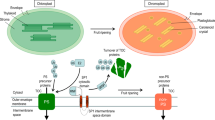Conclusion
Variegated and periclinal pelargoniums offer some very puzzling problems. Chittenden (1927) collected some of these cases, which, however, have become simplified as the result of my investigations. Two forms of variegation were identified, the one due to sorting out of mixed plastids, and the other to recurrent exomutation of plastids induced by a recessive stimulant gene that is mutable itself. Various plasmotypes of plastids differ in their colour, the degree of crumpling of tissues, and mutability. The plasmotypic change of plastids is either automutable or exomutable, while sometimes the plastids transform in two directions. The white-over-green periclinals generally have albinotic epidermis. In the majority of cases unstable chlorophyll periclinal types change into stable types, probably at the growing points. Freak of Nature, Chittenden’s variety A, and the green crêpe sport from Hanamikado are periclinals with differentiated ectohistogens, it being green in the first named and albinotic in others. The extent to which the respective three histogens contribute to the ontogeny of the plant body is considered from both anatomical and genetic investigations. Since in leaf formation of the pelargonium the ectohistogen develops into the marginal mesophyll as well as the epidermis, the mesohistogen into the outer and submarginal mesophyll, and the endohistogen into the innermost mesophyll, the chlorophyll periclinals with differentiated ectohistogens bear leaves with margins of a different colour.
Similar content being viewed by others
References
Bateson, W. (1919). “Studies in variegatoin. I.”J. Genet. 8, 93–9.
—— (1921). “Root-cuttings and chimaeras. II.” Ibid.11, 91–7.
Baur, E. (1907). “Untersuchungen über die Erblichkeitsverhältnisse einer nur in Bastardform lebensfähigen Sippe vonAntirrhinum majus.”Ber. dtsch. bot. Ges. 25, 442–54.
—— (1909). “Das Wesen und die Erblichkeitsverhältnisse der ‘Varietates albomarginatae hort’ vonPelargonium zonale.”Z. indukt. Abstamm.-u. VererbLehre,1, 330–51.
Chittenden, R. J. (1925). “Studies in variegation. II.”J. Genet. 16, 43–61.
—— (1927). “Vegetative segregation.”Bibliogr. genet. 3, 355–442.
Imai, Y. (1928). “A consideration of variegation.”Genetics,13, 544–62.
—— (1934a). “An apparently simple inheritance of variegation inPolygonum orientale.”J. Genet. 29, 148–51.
—— (1934b). “On the mutable genes ofPharbitis, with special reference to their bearing on the mechanism of bud-variation.”J. Coll. Agric. Tokyo,12, 479–523.
—— (1935a). “The structure ofalbomarginata andmedioalbinata forms.”J. Genet. 31, 53–65.
—— (1935b). “The mechanism of bud variation.”Amer. Nat. 69, 587–95.
—— (1936). “Chlorophyll variegations due to mutable genes and plastids.”Z. indukt. Abstamm.- u. VererbLehre,71, 61–83.
Noack, K. L. (1922). “Entwicklungsmechanische Studien an panaschierten Pelargonien. Zugleich ein Beitrag zur Theorie der Periklinalchimären.”Jb. wiss. Bot. 61, 459–534.
—— (1924). “Vererbungsversuche mit buntblättrigen Pelargonien.”Verh. phys.-med. Ges. Würzburg,49, 45–93.
—— (1925). “Weitere Untersuchungen über das Wesen der Buntblättrigkeit beiPelargonium.” Ibid.,50, 47–97.
—— (1930). “Untersuchungen anPelargonium zonale ‘Freak of Nature’.”Z. Bot. 23, 309–27.
Roth, L. (1927). “Untersuchungen über die periklinal bunten Rassen vonPelargonium zonale.”Z. indukt. Abstamm.- u. VererbLehre,45, 125–59.
Sabnis, T. S. (1932). “Inheritance of variegation. II.” Ibid.,62, 213–31.
Author information
Authors and Affiliations
Rights and permissions
About this article
Cite this article
Imai, Y. Geno- and plasmotypes of variegated pelargoniums. Journ. of Genetics 33, 169–195 (1936). https://doi.org/10.1007/BF02982531
Issue Date:
DOI: https://doi.org/10.1007/BF02982531




